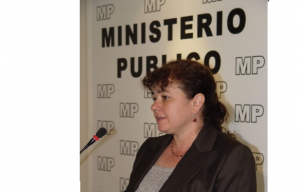. . WOMEN’S EQUALITY . .
An article by Claudia Paz y Paz Bailey and Melanne Verveer in openDemocracy (Claudia Paz y Paz Bailey was attorney general of Guatemala from 2010 until 2014)
In order to effectively reduce female murders, Latin American nations must combat one of the leading causes of death for women—gender-based violence—whereby perpetrators target victims because of their gender and act in the context of unequal power relations between men and women.
Guatemala presents a case study of how innovative 24-hour courts and revised trainings for law enforcement can increase convictions related to gender-based violence and ultimately reduce the number of female murders.

Claudia Paz y Paz Bailey
(Click on photo to enlarge)
Guatemala’s high female murder rate—9.1 murders for every 100,000 women between 2007 and 2012—is impacted by regional crime, drug trafficking, and gang violence. But at least half of female murders in Guatemala are femicides.
Guatemala was the first country to officially recognize femicide—the murder of a woman because of her gender—as a crime in 2008. Four years later, the country created a national database to record basic data on all cases of violent deaths of women. This database allowed the Attorney General’s office to identify weaknesses in the investigation of femicides and the gender-based violence that often precedes them, and subsequently to develop pilot programs to address crimes associated with violence against women before they escalated to murder.
Most notably, the Attorney General’s office and the Supreme Court of Justice collaborated in 2012 to establish a 24-hour court to handle urgent investigative measures required in gender violence crimes immediately. The court operated inside the Comprehensive Care Model (Modelo de Atención Integral) created in 2009, and offered a model of comprehensive services: forensic experts, police, psychologists, clinical physicians, and prosecutors were all brought together in a single space in Guatemala City to serve the survivors of gender-based violence.
In the Comprehensive Care Model, it was the institutions that revolved around women, rather than women having to travel to each institution or worse, having to choose between medical care and access to justice. The 24-hour court, one of the first in Latin America, immediately increased the number of protection measures and arrest warrants authorized, and led to an increase in the number of people sent to prison for violence against women and sexual exploitation.
(article continued in right column)
(Click here for the original Spanish version of this article.)
Protecting women and girls against violence, Is progress being made?
(article continued from left column)
At the same time, Guatemala also took efforts to address prejudicial or inadequate investigations, which limited women’s access to justice. The Attorney General’s office had found that officers in charge of gender-based violence investigations tended to blame the victim because of her way of dressing, her prior conduct, or her prior or family relationship with the perpetrator. It was common to hear “algo haría” (she must have done something) or “ella se lo buscó” (she was looking for it).
Investigators also failed to take account of the context of crime: they frequently neglected to inquire whether there had been prior acts or reports of violence against women or sexual violence concurrent with the murder, or whether the victim resided in an area where any criminal organization operated.
Further, violence against women was treated with little importance by judges. This translated into delays before evidence could be collected or an arrest warrant or a search warrant was issued; these cases were the last in line on the agenda of court hearings.
In response, Guatemala began to offer specialized training for prosecutorial officers investigating cases of sexual violence, violence against women, and femicides. Once a victim approached the Attorney General’s office, she was made to feel protected. New instructions guided the investigations of intimate femicide, sexual femicide, and femicide in the context of a criminal group or organization, especially gangs or organizations associated with drug trafficking.
In the year following these innovations, the convictions for female murders in Guatemala rose from 55 to 91. This increase in convictions translated into far fewer cases, from 393 (178 resulting in death) in 2010 to 193 (103 resulting in death) in 2013 in Guatemala City.
The trend in convictions and cases was not observed at the national level, where the model has yet to be fully implemented. This must be done: Guatemala must expand 24-hour courts and trainings for law enforcement around the nation, and throughout the region. This deployment should be accompanied by non-criminal measures for preventing violence against women, such as educational policies and those aimed at greater gender equality in economic and political matters.
Many survivors of gender-based violence in Guatemala have told us that, today, they know justice is possible in Guatemala. While Guatemala is still struggling to effectively combat violence against women, these localized interventions present a promising model for expanding women’s access to justice in the region.
(Thank you to Janet Hudgins, the CPNN reporter for this article)